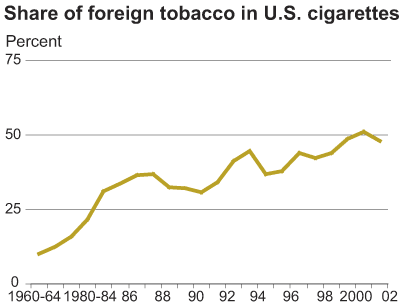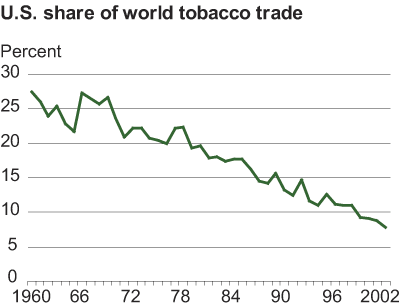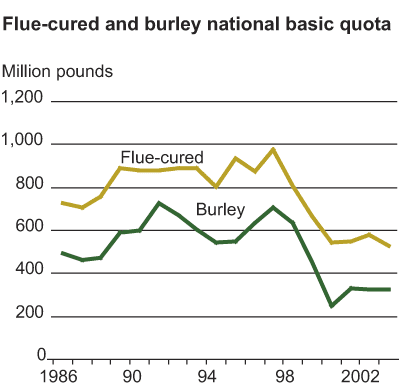U.S. Tobacco Industry Responding to New Competitors, New Challenges
- by Thomas Capehart
- 9/1/2003
Tobacco growers are facing tough times as cigarette consumption shrinks and foreign producers edge them out of formerly lucrative markets. Not only have U.S. exports of tobacco leaf declined, but cigarettes manufactured in the United States now contain more foreign tobacco than ever before—nearly 50 percent. Why is U.S. tobacco losing ground to other countries? Price, mainly. With cheaper tobacco available on the world market, U.S. tobacco is losing global and domestic market share.
U.S. tobacco imports have significantly increased due to price competitiveness and higher leaf quality by overseas producers—the result of improved cultivation and marketing techniques. In the past, the superior quality of U.S. tobacco compensated for its higher price. But the dramatic increase in the quality of foreign leaf during the past 25 years no longer “protects” U.S. tobacco.
As the quality gap between U.S. and foreign produced leaf narrows, the price gap is increasing. In 2002, Japan, our leading and most loyal tobacco customer, purchased leaf from Brazil for the first time…and the U.S. share of world tobacco trade dropped to 8 percent, an all-time low.
Trade has always been an influential force in the global tobacco market. The U.S. is unique in that it is both a big tobacco-producing and consuming country. Countries that produce tobacco at low cost—Zimbabwe and Malawi, for example—tend to consume little tobacco and seek opportunities in lucrative markets, such as the European Union and Japan, where little tobacco is grown and production is costly. While trade policy reforms in the past decade have led to considerable shifts in trade for many commodities, tariffs on tobacco in major importing countries have always been relatively low.
Tobacco Program, Now 65 Years Old, Ready for Change?
This changing global environment—and the increasing competitiveness of low-cost producing countries—is putting pressure on the U.S. flue-cured and burley tobacco program. (These two types account for 93 percent of U.S. tobacco output.) Created in 1938, the program was originally designed to provide a steady supply of high-quality leaf tobacco and to stabilize and support grower incomes through price supports and marketing quotas (see “The Tobacco Economy”).
Quota is the amount of flue-cured or burley tobacco leaf a producer can sell during a given season and is a requirement for marketing these two types of tobacco in the United States. That is, unless a producer either owns quota or leases it from a quota owner, the producer cannot sell these types. Quota levels are revised annually according to recent demand and have declined drastically since the 1990s, as U.S. cigarette consumption has dropped and imports of tobacco leaf have risen.
The program also guarantees growers a floor price and a market for flue-cured and burley leaf. But over the years, price supports have risen and the discrepancy between U.S. and world leaf prices has become steadily larger. In 1960, grower prices in the United States averaged 60 cents per pound for flue-cured tobacco, compared with 40 cents per pound in Zimbabwe. By 2000, the difference was 60 cents per pound. Likewise, in 1960, U.S. burley prices were 25 cents per pound above prices in Malawi. In 2000, the spread was $1.40 per pound.
Because of the way the support price is calculated, the tobacco program nearly always results in annual price increases. The price depends on the average U.S. cost of producing leaf (which almost always goes up from year to year) and recent annual prices. Higher prices beget sliding demand (and greater imports), which results in smaller quotas, because expected domestic demand and export demand, significant factors in the quota calculation, are lower. The downward spiral caused by higher prices—prices rise, demand decreases, quotas shrink, but prices still continue to increase—is the cause of much of the tobacco farmers’ woes…and their current interest in a buyout.
In the late 1990s, legislators from tobacco-producing States proposed alternatives to the quota program. Many of these proposals included some form of buyout, in which the government would purchase the quota from the owner in order to move the tobacco industry toward a “free market” system. Quota holders would be compensated for the loss of future income from renting their quota to others or growing tobacco using their own quota.
At that time, the idea of a tobacco quota buyout program got mixed reviews from tobacco farmers. Many older farmers supported a buyout as a path to a secure retirement, but younger growers often preferred the stability and revenue the program guaranteed. Drastic cuts in quotas starting with the 2000 crop changed the picture. Quotas in 2003 are only 63 percent of 1999 levels. As a result, the notion of quota buyouts is now more favorably received by growers at auction warehouses and country cafes in tobacco country. This renewed interest has also united unlikely bedfellows: health advocates and tobacco grower organizations. These groups have aligned to promote legislation that couples a quota buyout with continued production controls for growers and regulation of tobacco products by the Food and Drug Administration (FDA). How did this turnabout happen, what are options for reform, and what are the consequences of a traditional U.S. cash crop “cashing out”?
Quota Buyout Seeks To Restore U.S. Competitiveness. . .
Most tobacco leaf grown by U.S. producers follows one of three paths. It can be sold to the domestic cigarette industry for cigarette consumption here, sold to the domestic industry for manufacture and export of cigarettes, or exported in its leaf form. No matter which path the leaf follows, it faces competition from foreign sources.
Cigarettes made by domestic manufacturers contain both U.S. and foreign tobacco, with increasing amounts of the latter. High U.S. tobacco prices, competition from upstart cigarette companies making generic cigarettes, and large payments to States under the Master Settlement Agreement MSA, (see “Master Settlement Agreement”) have made large cigarette manufacturers receptive to less expensive imported leaf—particularly given its increased quality.
The inability of U.S. growers to rapidly adapt volume and price to changing conditions puts them at a further disadvantage in the global market. For instance, when production in Zimbabwe plummeted due to political unrest and land reform, Brazilian roducers were able to rapidly increase production and expand exports. But, because of the quota program, U.S. growers are unable to take advantage of opportunities in the world marketplace. Tobacco quota adjustments are based on past, not current or future, market conditions.
. . .And Boost Profitability
Despite increased foreign competition and the constraints of the quota program, American tobacco farmers still find tobacco a profitable crop—far more profitable than the alternatives. An average grower in North Carolina produced 27 acres of tobacco, about 54,000 pounds of leaf, in 1997, the latest year for which detailed production data are available. Those 27 acres yield about $100,000 of tobacco leaf. In comparison, the same 27 acres yield about $6,500 of corn. Corn isn’t the only alternative, of course. Niche crops can be profitable, but often markets are limited.
At the same time, growers are faced with shrinking quota. Without access to sufficient quota, growers are unable to maintain the economies of scale needed to keep their production costs down.
For those who farm using another’s quota—through leasing, for example—growing tobacco is still profitable but less so, at least on a cash basis, because they must compensate the owner of the quota. Depending on the year, renting or leasing quota can add up to 75 cents per pound, or nearly 40 percent, to a grower’s expenses. The elimination of the cost of renting quota would enable these producers to maintain profits at a lower price.
Those growers who own quota do not have the expense of renting quota, but they must consider the opportunity cost to owning it—they could sell it and use the money elsewhere. As the national quota shrinks due to lower demand for leaf, competition for rental quota further inflates the cost of growing tobacco, eating into producer profits.
For all these reasons, grower interest in a buyout is at an all-time high. Quota owners see an opportunity to exit the industry with a generous payment. Growers who are currently leasing quota anticipate a transition payment, elimination of quota rental payments if they continue growing tobacco, and the potential for lower per-acre production costs if they have greater flexibility to expand their acreage.
What Might the Policy Future Hold?
A wide range of policy options exists. On one end of the policy continuum is the total dissolution of the program—letting market forces determine the location, volume, and price of tobacco production. In this scenario (and others discussed below), total U.S. acreage and acreage per farm would likely increase. Prices would drop, imports would likely decline, and the U.S. share of both domestic and global markets would increase. Land values formerly propped up by the value of quota would decline during the adjustment to a free market.
At various points between the free-market end of the continuum and the restrictive end lie the buyout proposals currently being debated in Congress. Many of these proposals originate from the principles outlined in a 2001 Presidential Commission Report, Tobacco at a Crossroad: A Call for Action. Under such proposals, quota holders (owners) would typically receive a fixed payment per pound for their quota, paid over a period of years. Currently, there are about 400,000 quota owners, and they range from large, business-oriented holders to former tobacco farmers and retired people. Producers who do not own quota would be paid a transition payment to help them adjust to a free-market environment and to encourage diversification into other enterprises. During the mid-1990s, the 80,000 farmers who grew flue-cured and burley tobacco planted 60 percent of their tobacco using others’ quota (see “How a Buyout Proposal Might Operate”).
Some proposals include licenses as a substitute for quotas, in order to continue some form of control over production. Licenses would differ from quotas in several ways. Licenses would be issued to individuals and would stay with those individuals until the license holder dies and passes the license on to someone else. Licenses would not be bought, sold, or rented, and, therefore, would not add to the cost of growing tobacco. As such, licenses would negatively affect competitiveness less than quotas. Licenses would also carry geographic restrictions to prevent production from leaving traditional areas.
Price support at some level has also been proposed for a revised tobacco program—with or without licensing. Lower levels of price support would move policy along the continuum of policy options toward a free-market orientation, while higher support levels would be more protective. Price support could be continued indefinitely, could provide a period of time for growers to acclimate to the new economic environment, or could terminate altogether at a sunset date. Price supports could be in effect for a producer’s historical level of production, but not protect production above that level.
Some policy proposals toward the restrictive area of the continuum combine price supports and licensing with FDA regulation. These proposals combine goals dear to both tobacco growers and health advocates. From a health promotion perspective, a program that enhances quality control and health and safety standards for tobacco leaf is in the interest of the health community. Inspections for pesticides and other chemicals at all levels of the production chain is a goal that health advocates say would reduce harm from tobacco products. Health advocates also want future tobacco crops to be grown in traditional areas, where monitoring can be carried out by knowledgeable people.
The status quo—the program that currently exists—is at the most restrictive end of the continuum, where market forces are constrained by various types of interventions. Current levels of price supports are not competitive in world markets. Costs are higher, because some production rights are controlled by nonproducing quota owners. And, U.S. growers are increasingly noncompetitive as imports increase, quota levels shrink, and the price support level rises. Preservation of the status quo all but guarantees continued decline in quota levels to the point where the U.S. tobacco industry could become a minor supplier of tobacco.
Many Scenarios Are Possible
Tobacco continues to be an important U.S. crop, but recent world market pressures on tobacco producers and continuing concern about the health effects of cigarettes have renewed interest in proposed buyout programs for tobacco quota holders. A buyout would eliminate quota restrictions on tobacco production, but in most proposals, some form of production control and price support would continue. Eliminating quota rental costs, which inflate the price of U.S. versus foreign leaf, would enhance U.S. competitiveness in domestic and foreign markets.
Part of the impetus for a buyout is to increase the competitiveness of U.S. tobacco by narrowing the gap between its price and that of other countries. In a post-buyout environment, as the U.S. price falls, purchases of U.S. tobacco would increase both domestically and by foreign customers. Growers would respond to this increase in demand as much as possible within the limits of the post-buyout program. In a free-market, no-program environment, production would increase rapidly. If constraints exist because of continued market intervention, any increase would be slower.
Although health groups do not necessarily want tobacco production to increase, they may accept smokers’ consuming U.S. tobacco produced under a stringent regulatory environment with careful inspections for banned chemicals. Linking the goals of a tobacco quota buyout and FDA regulation of tobacco products has advantages for both producers and health interests. Tobacco buyout advocates can garner widespread support for an issue that affects only a handful of States, and health regulation watchdogs get support in States traditionally opposed to tobacco product regulation.
A post-program regime without geographical restrictions on tobacco production could upend the structure of the U.S. tobacco industry. Production may move to areas where larger, more efficient units could be assembled. Production in areas such as the Piedmont or hilly regions in Kentucky, where tract size is traditionally smaller, likely would decline. Tobacco farms would grow bigger and the number of growers would drop. And, some production would likely shift to States that have never grown tobacco, along with attendant economic consequences.
This article is drawn from:
- Capehart, T. (2001). Trends in the Cigarette Industry After the Master Settlement Agreement. U.S. Department of Agriculture, Economic Research Service. TBS-250-01.
- Tobacco Quota Buyout Proposals in the 108th Congress. (2003). Congressional Research Service, Library of Congress.
- Tobacco at a Crossroad: A Call for Action. (2001). President’s Commission on Improving Economic Opportunity in Communities Dependent on Tobacco Production While Protecting Public Health.
You may also like:
- ERS Tobacco Briefing Room. (2008). USDA, Economic Research Service.




